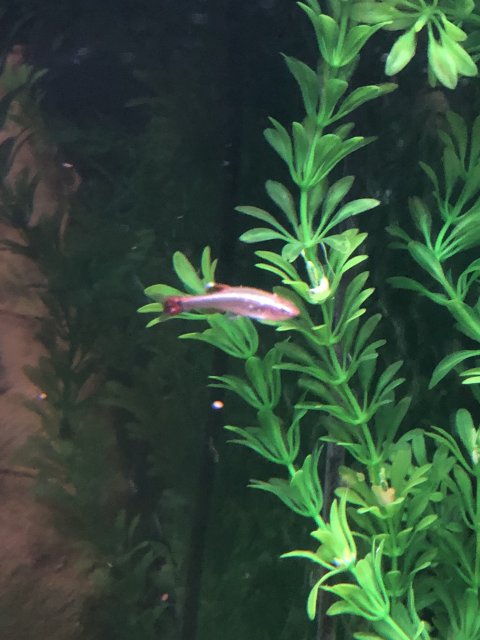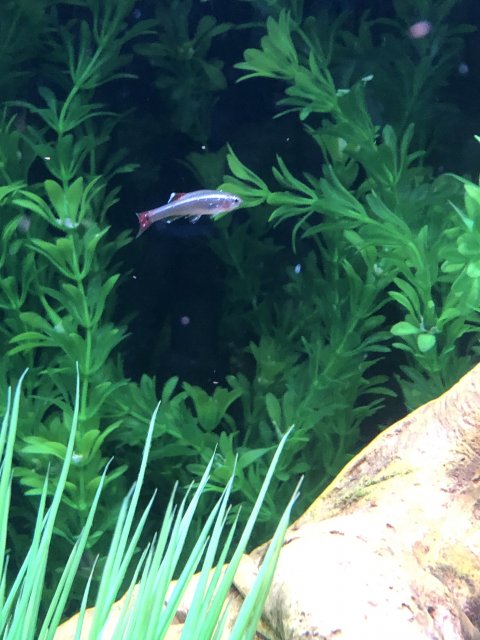Is this Ich?
- Thread starter railer20
- Start date
You are using an out of date browser. It may not display this or other websites correctly.
You should upgrade or use an alternative browser.
You should upgrade or use an alternative browser.
Based on the 2nd picture, it looks like ick! Need to act on it immediately.
Yes put it in a bucket and do hot (80-86 degree) wc and treat with methylene blue
It does look like it based on the pics. It's possible that fish is weakened to the point it's showing signs of the ich parasite while others are not.
There's lots of good info on the site on how to tread it and you don't necessarily need meds to do so.
Don't get discouraged! We've all been through it.
There's lots of good info on the site on how to tread it and you don't necessarily need meds to do so.
Don't get discouraged! We've all been through it.
Let's talk about Ich and how to get rid of it. Do not remove the fish and treat them in an H tank. Ich is now in your tank and it will infect other fish. To understand why we should do this, we need to know about the life cycle of Ich.
An assessment of the use of drug and non-drug interventions in the treatment of Ichthyophthirius multifiliis Fouquet, 1876, a protozoan parasite of freshwater fish
S. M. Picòn- Camacho* , M. Marcos - Lopez**, J. E. Bron* and A. P. Shinn*
* Institute of Aquaculture, University of Stirling, FK9 4LA Stirling, UK
** Marine Laboratory, 375 Victoria Rd, AB11 9DB Aberdeen, UK
(Received 17 June 2011; revised 12 September 2011; accepted 16 September 2011; first published online 14 November 2011)
That study reviews the efficacy of more treatments (many not drugs) than most of us even knew existed. It tells what and how much was dosed, how (bath, dip feed or injection) and how effective it was killing ich and in which life stages. Table 1 lists all of the chemical treatments known/ It begins on page 8 and end on page 37. Table 2 runs another page and a half and deals with Management strategies tested against infections of Ich.
The reason we treat the whole tank is there is a good chance there is ich in the trophont and/or tomycist stage in our tank which will survive a short term treatment. The result then is that the Ich can return pretty quickly.
I have only had to treat ich twice in 20 years. Both times I used a traditional formalin malachite green mixture. I also raised the water temperature as high as was safe for the fish in the tank. Doing this speeds up the life cycle and makes it easier to kill the ich fatser.
An assessment of the use of drug and non-drug interventions in the treatment of Ichthyophthirius multifiliis Fouquet, 1876, a protozoan parasite of freshwater fish
S. M. Picòn- Camacho* , M. Marcos - Lopez**, J. E. Bron* and A. P. Shinn*
* Institute of Aquaculture, University of Stirling, FK9 4LA Stirling, UK
** Marine Laboratory, 375 Victoria Rd, AB11 9DB Aberdeen, UK
(Received 17 June 2011; revised 12 September 2011; accepted 16 September 2011; first published online 14 November 2011)
From: http://dspace.stir.ac.uk/bitstream/1893/10147/1/Picon%20Camacho%20et%20al%20Parasitology%20Ich%20chemo%20review.pdfIt has a direct life cycle, which is temperature dependent such that the warmer the water temperature the faster the life cycle completes. The life cycle involves 4 different stages: (1) the trophont, which resides within the surface epithelium of gills, fins and other body surfaces; (2) the protomont, a free-swimming stage that exits the fish and settles on the substrate to become the encysted tomocyst stage (3) which in turn repeatedly divides by binary fission to produce tomites which are released to the water column. Tomites differentiate into the infective stage (4) the theront, which needs to find a host within a short window to successfully complete the life cycle by penetrating the epidermis and developing into the trophont stage before it dies (Lom and Dyková, 1992; Matthews, 2005). Theronts can survive for up to 92 h at low water temperatures; their survival being inversely proportional to the ambient water temperature (Wagner, 1960; Aihua and Buchmann, 2001).
On farms, the most common approaches to treat this ciliate is through the use of either short (e.g. 30 min–4 h in tanks, raceways and flow-through systems) or long (e.g. 7–15 days in pond culture) duration in-bath treatments which target the free-swimming stages of the parasite (i.e. protomonts and theronts). Of the other two stages, the trophont is protected lying underneath the host surface epithelium (Post and Vesely, 1983) whilst the tomocyst is protected by a resistant coat (Ewing et al. 1983) and as such, are rarely susceptible to
treatment.
That study reviews the efficacy of more treatments (many not drugs) than most of us even knew existed. It tells what and how much was dosed, how (bath, dip feed or injection) and how effective it was killing ich and in which life stages. Table 1 lists all of the chemical treatments known/ It begins on page 8 and end on page 37. Table 2 runs another page and a half and deals with Management strategies tested against infections of Ich.
The reason we treat the whole tank is there is a good chance there is ich in the trophont and/or tomycist stage in our tank which will survive a short term treatment. The result then is that the Ich can return pretty quickly.
I have only had to treat ich twice in 20 years. Both times I used a traditional formalin malachite green mixture. I also raised the water temperature as high as was safe for the fish in the tank. Doing this speeds up the life cycle and makes it easier to kill the ich fatser.
TwoTankAmin pretty much covers it all. To sum up: Don't remove them from your tank, you need to treat the tank. Even with the white clouds you'll be good to go up to 80 or 82 degrees for a few days. You don't have to use a medication to treat it. I've only had ich twice in the last 25 years and only once in the last 10, both times in quarantining fish. My personal preference is to use a medication when treating.
WYite
WYite
Actually, separating the fish is a not a bad idea. Contrary to popular belief, other fish don't have to be infected. They may be, but you can deal with that later. And people hate to hear this but there are ich strains now that are resistent to malachite green, temperature and salt, due to improper and overuse of these methods. You do not want to experiment with treating these strains in your tank while other fish are getting infected.




